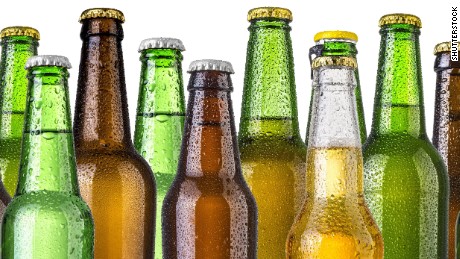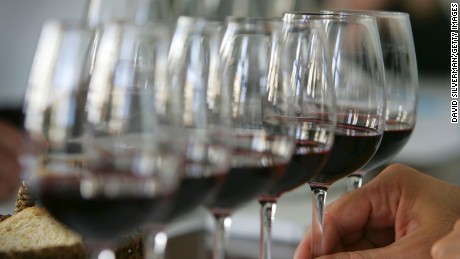Story highlights
- Reduced-calorie wines have about 15% to 30% fewer calories than regular wine
- Lower-calorie wine usually just means lower alcohol content
(CNN)If you're counting calories, a glass of wine might be your alcoholic beverage of choice, as it's a lighter option than many other mixed drinks.
Reduced-calorie wines can save you even more calories, perhaps enough to earn a few bites of cheese or chocolate. Of course, you have to also ask yourself: Are you actually enjoying it?
The savings
Depending on the variety, reduced-calorie wines have about 15% to 30% fewer calories than regular wine. For example, at 90 calories per 5-ounce glass, FitVine's lower-calorie white wines have 25% fewer calories than a glass of regular white table wine, which has about 120 calories.
If you are sticking to current recommendations for moderate drinking -- that is, limiting yourself to one or two glasses of wine each day -- you would be saving 30 to 60 calories a day. In the case of Skinnygirl wine, you save even less: about 20 to 25 calories per glass. Overall, that's not a huge savings for something that is considered an indulgence.
"If you're drinking two glasses of low-cal wine a day versus 'regular' wine, you've eliminated 60 calories out of an average 2,000-calorie diet. That's 3% of your total calorie intake. To me, that doesn't seem like enough of a calorie reduction to be concerned about, but I'm not a triathlete," said Dwayne Bershaw, who teaches winemaking classes in the Department of Food Science at Cornell University.
Sugar is a hot topic these days, and some reduced-calorie wines claim to have practically no sugar at all. For example, FitVine claims its wines have less than 0.2 grams per 5-ounce glass. However, according to Bershaw, "there are many high-quality whites, and most reds, which contain very little residual sugar. So, from this perspective, these wines are just like many others on the market."
In fact, according to the US Department of Agriculture's national nutrient database, a 5-ounce glass of red table wine typically contains less than 1 gram of sugar, while a glass of white wine contains about 1.4 grams.
The more alcohol, the more calories
The way to reduce calories in wine is to lower the amount of alcohol, according to Bershaw. "Unless we are talking about overtly sweet wines, alcohol content is by far the largest driver of calories," he said.
But this creates a bit of mystery. FitVine's ABV (alcohol by volume, a measure of how much alcohol is in a given amount of a drink) ranges from 13.4% to 13.9%, similar to other wines, according to Bershaw. He is unsure why FitVine's reduced-calorie wines are lower in calories than other wines with a similar alcohol and sugar content.
When Bershaw did a calculation for a lower-alcohol (12.5%) Riesling, it was slightly lower in calories than FitVine's wines because of the lower ethanol (alcohol) content. In other words, there may be other lower-calorie wines out there, but they just may not be marketed as such, he explained.
Cense's Sauvignon Blanc, the product of a partnership between Truett Hurst Wineries and Weight Watchers, is made using an exclusive technology that offers consumers a wine with an ABV of 9.6% and only 85 calories per 5-ounce glass (or three SmartPoints). "In essence, we can capture the alcohol and take what percentage out we want, but we keep the aromas and essences and mouthfeel of a full alcohol wine," said Jason J. Strobbe, Truett Hurst's executive vice president. He said the company will be releasing a lower-calorie ros├® in February.
"Low-alcohol wines can be great-tasting wines, and they are usually more food friendly (pairing well with meals) than the high-alcohol wines that were popular five to 10 years ago" Bershaw said. "Plus, you can drink two or three glasses without feeling like you need to go to bed early."
The bottom line
Though reduced-calorie wines have fewer calories, it's not enough to justify an extra glass or two. If you drink more to compensate for the reduced calories, you will consume more alcohol and calories overall. For example, two glasses of white wine have about 240 calories, but three glasses of lower-calorie (FitVine white) wine have 270 calories -- and more alcohol than you should be consuming on a daily basis anyway.
Wine may protect our hearts and reduce diabetes risk when consumed in moderation -- defined as up to one drink per day for women and up to two drinks per day for men -- but drinking more can increase health risks.
"Just because we can make lower-alcohol wine that's also lower in calories doesn't mean that people should drink more of it," said Ginger Hultin, a registered dietitian and spokeswoman for the Academy of Nutrition and Dietetics.
Wine experts say the flavor of wine and how well it pairs with food matters, in addition to a wine's nutritional facts, which are not even required on wine labels and therefore makes it difficult for consumers to choose wisely. "This topic would be much easier for consumers to navigate if winemakers were forced to list both ingredients and the calorie content of their products," Bershaw said.
"I think each person has to decide what they like about the wines they drink," said Stephen Mutkoski, professor emeritus of wine education and management at the School of Hotel Administration at Cornell University.
"For me, it is flavor, balance and how it works with the food I am planning to cook or order in a restaurant. Personally I would never give up these important attributes to consume 25 or 30 calories less. If you give up one dessert a week, you can probably save more calories and enjoy a range of wines all week long and still come out ahead on the caloric scale."
Bottom line: Choose the wine you like the taste of best, limit your intake, and savor every sip.







